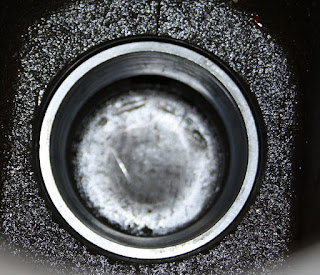The steering on my 1953 Ford Golden Jubilee (Model NAA) completely froze up a few weeks ago in a back field. My son and I had to disconnect the drag links from the front axle spindle arms, tie a rope to both spindle arms, and bring the machine home using the rope like reins on old Bessy.
We dismantled the steering gearbox to find that the oil had leaked out over the years, and the bearings inside had completely disintegrated.
Removal of the lower bearing race in the gearbox posed a problem. Shown below, it's 5-1/4" inches below the mouth of the gearbox.
You can't really see them in the photo below, but the Ford engineers had thoughtfully had two slots milled below the bearing seat, 180 degrees apart. I initially tried a slide hammer with a hooked end inserted into each recess to try to release the race, but no go. The bearing race is a very tight fit. This is also a big cast iron housing, so heating it to try to expand it around the steel race would take quite a lot of energy.
So, I dug around in my collection of round steel stock and came up with a piece I could use as a puller. Below, the finished piece. It consists of a stepped cylinder with a hole drilled cross-wise through it to hold two sliding steel pins. The cylinder is tapped to accept a 5/8"-11 threaded rod, chamfered on the lower end. The steel pins are made from drill rod. In use, you drop the cylinder with the recessed end downward through the lower race. Then you use a screwdriver to push the pins into the recesses under the race. The chamfered end of the threaded rod is inserted and screwed down so that the chamfer acts like a wedge, holding the two steel rods in place. The threaded rod extends up through the mouth of the gearbox housing. All you need to do is put a piece of steel plate (with a centered hole for the rod) across the top of the housing mouth, run a nut on the rod down to the plate, and then begin tightening the nut to lift the lower race right out. Worked like a charm.
Below, the puller inside the race before the pins are extended.
Below, the pins are now extended so that they bear on the bottom of the race. My pins are 0.186" O.D., just because that was available. I drilled the holes to 0.1960" (No. 9 drill), but it might be better to go slightly smaller, maybe No. 11 (0.1910"). I left the holes on the sloppier side in case they simply jammed in place without pulling out the race, so that it would be easier to remove them in order to release the tool if it hadn't worked. (I didn't bother facing the end of the steel piece, since I wasn't worried about appearance, hence the rough look of it above and below.)
Below, the threaded rod, puller end, and old race.
To make the puller end, I simply used a piece of round stock that fit approximately. Since the inside diameter of the lower race is 1.330", ideally the outside diameter of the top end of the puller could be made just slightly smaller than this. You still need to slightly turn down the lower end of the puller, since the recess below the bearing race in the gearbox is tapered and you need a smaller diameter to drop the puller enough to have room to engage the pins. The threaded rod should be about 8 inches in length, ideally with flats milled or filed on the top end to allow it to be held stationary with a wrench while the nut is being tightened to draw the bearing race out. (In my own case, I actually didn't find it necessary to hold the rod from revolving, so I didn't need to mill the flats.)
Below, a rough drawing of the puller. Bear in mind I did not get good marks in my high school drafting course!
I put this out there in case it helps someone else who might have to accomplish this job on another NAA, or on earlier N-series Ford tractors with similar steering gearboxes.
Update: John, from the fantastically useful website Smith's Old Ford Tractors, gave me this advice:
That's a nice puller you made, but you took the long way around. That dimpled piece you see under the lower race is a standard welch plug. You just flip the housing over, use a drift to knock the welch plug out thru the race, then you have access to drive the race out with a small diameter drift. To replace, drive in a new welch plug and drive in the new race. About a 3 minute job. Or, you could weld a bead around the inside of the race. When it cools, the race will shrink and fall out. But, you should still replace the welch plug just to prevent future leaks.








2 comments:
As someone on a Ford N forum answered to a question about changing the steering box oil, " Which decade did you change it last?"
THANK YOU so much for posting the dimensions for the removal tool!!!!! I have been looking everywhere for something to get that bottom bearing race out of the steering box to my 861, had a hell of a time getting the other one out!
Post a Comment